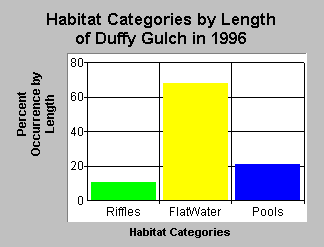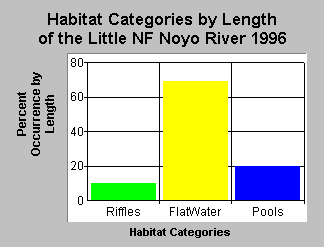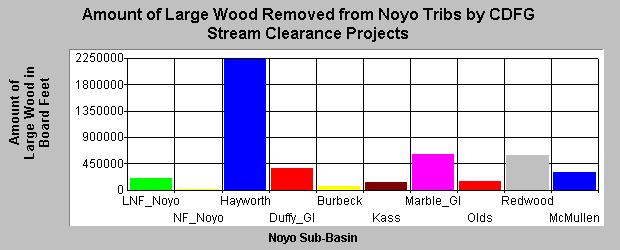Bibliography Background About KRIS
Hypothesis #4: Reduced large wood supply has contributed to the loss of pool habitat and the decline of coho salmon in the Noyo River basin.
Support for the hypothesis: From the literature
Stillwater Sciences (1997) studied the history of large wood removal in Mendocino County for the Louisiana Pacific Corporation as part their Sustained Yield Plan. They actually advanced this hypothesis as part of their report:
"One of the working hypotheses concerning coho salmon ecology and management in Mendocino County streams is that large woody debris (LWD), and the rearing habitat that it provides, may currently be the most important factor limiting coho populations. The well-documented role of LWD in coho salmon ecology, combined with the observation that the recent decline of coho salmon in California appears to be somewhat coincident with large-scale LWD removal programs led quite naturally to this hypothesis."
Large wood is an extremely important element in helping create and maintain fish habitat diversity, especially in coastal streams (see Big Wood background page). Coho salmon favor pools formed by large wood for rearing and addition of large wood can help increase pool frequency and coho salmon production (Cedarholm et al., 1997). Poole and Berman (1999) found that large wood may also help with stream cooling by forcing more stream flow into shallow ground water (hyporheic zone).
Large wood removal in Mendocino coastal streams, including the Noyo River, is well documented (Holman and Evans, 1964). See the page on Stream Clearance page to find out why large wood was removed from streams as part of early restoration efforts. While large wood has been considerably reduced, habitat typing surveys found that it was still an important contributor to pool formation in many Noyo River tributaries (Georgia Pacific, 1996). Keithley (1999) found that recruitment potential for large wood was low in many Noyo River tributaries because of timber harvests in riparian zones and that only 23% of riparian zones in low gradient reaches favored by salmon had trees over 24 inches in diameter.
From Noyo Data
Source Topics: The charts below are derived from the Topics listed here. Check these Topics in the KRIS database to see the information in context and to access the InfoLinks and Metadata.
(MN) Habitat Typing: Duffy Gulch Percent by Length
(MN) Habitat Typing: Little North Fork Noyo Percent by Length
(LN) Restoration: Large Wood Removal Estimates
 |
 |
|---|---|
| The chart above shows that Duffy Gulch in the Middle Noyo Basin has a pool frequency by length of 21%, according to a Georgia Pacific 1996 (a) habitat typing survey. CDFG (1967) estimated that pools formed approximately 30% of habitats in Duffy Gulch in 1966. The drop in pool frequency could be at least partially due to the removal of over 350,000 board feet of large wood. | The Little North Fork Noyo was comprised of 20% pools by length as of 1996 according to a Georgia Pacific habitat typing report (GP, 1996c). The report estimated that 40% of existing pools are formed by large wood. It is estimated that over 200,000 board feet of large wood was removed from this sub-basin as part of stream clearance (see below). |

The chart above shows an estimate of the amount of large wood removed from Noyo River basin tributaries by CDFG large wood removal projects. These projects were thought to improve fish passage and assist in flushing of sediment to restore spawning gravel quality (see Stream Clearance).
Alternative Hypotheses
Large wood removal was of little consequence, pool frequency dropped for other reasons as did coho abundance.
Evidence is presented in support of Hypothesis #2 that suggests that sedimentation may have reduced pool volumes, which would support in part this alternative hypothesis. High water temperature could also be a competing mechanism for coho decline as advanced in Hypothesis #3.
Monitoring Trends to Support or Refute the Hypothesis
Experiments are already being conducted on Jackson Demonstration State Forest by the California Department of Fish and Game (Collins, 1999) to determine whether pool frequency and depth can be improved on Parlin Creek through the addition of large wood to the stream. This experiment will be expanded to also measure the response of coho salmon juveniles to changes in habitat conditions (Collins, 1999) and thereby provide evidence which will support or refute this hypothesis.
References
California Department of Fish and Game. 1967. Duffy Gulch Stream Survey Report. CDFG, Region 3, Yountville, CA.
Cedarholm, C.J., R.E. Bilby, P.A. Bisson, T.W. Bumstead, B.R. Fransen, W.J. Scarlett and J.W. Ward. 1997. Response of Juvenile Coho Salmon and Steelhead to Placement of Large Woody Debris in a Coastal Washington Stream. North American Journal of Fisheries Management. 17:947-963.
Collins, B.W. 1999. Parlin Creek Large Woody Debris Placement Project. Jackson Demonstration State Forest Newsletter. Volume 51 (Spring/Summer). CA Department of Forestry and Fire Protection, Mendocino Ranger District.
Georgia Pacific. 1996a. Habitat Typing Report: Duffy Gulch, Middle Noyo River Basin. Georgia Pacific, Ft. Bragg, CA.
Georgia Pacific. 1996b. Habitat Typing Report: Kass Creek. Georgia Pacific, Ft. Bragg, CA.
Georgia Pacific. 1996c. Habitat Typing Report: Little North Fork Noyo River. Georgia Pacific, Ft. Bragg, CA.
Georgia Pacific. 1996d. Habitat Typing Report: Mainstem Noyo River. Georgia Pacific, Ft. Bragg, CA.
Georgia Pacific. 1996e. Habitat Typing Report: Switchback Gulch, a Noyo River tributary. Georgia Pacific, Ft. Bragg, CA.
Georgia Pacific. 1996f. Habitat Typing Report: Unnamed Tributary to Duffy Gulch, Middle Noyo River Basin. Georgia Pacific, Ft. Bragg, CA.
Holman, G. and W. Evans. 1964. Noyo River Stream Clearance Projects. California Department of Fish and Game. 12 p.
Keithley, C. 1999. Evaluating Stream and Watershed Conditions in Northern California. Prepared for the California Department of Forestry, Fire and Resource Assessment Program. Sacramento, CA. 17 pp.
Poole, G.C., and C.H. Berman. Submitted. Pathways of human influence on water temperature dynamics in stream channels. Environmental Management. 20 pp.
Stillwater Sciences. 1997. A review of coho salmon life history to assess potentially limiting factors and the implications of historical removal of large woody debris in coastal Mendocino County. Prepared by Stillwater Sciences, Berkeley CA for Louisiana-Pacific Corporation, Wildlife and Fisheries Science Group, Forest Resources & Fiber Procurement Division. May 1997. 55 pp